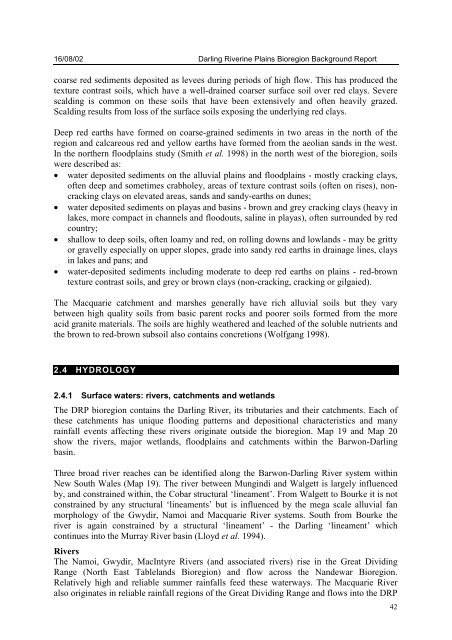DARLING RIVERINE PLAINS BIOREGION Background Report
DARLING RIVERINE PLAINS BIOREGION Background Report
DARLING RIVERINE PLAINS BIOREGION Background Report
Create successful ePaper yourself
Turn your PDF publications into a flip-book with our unique Google optimized e-Paper software.
16/08/02 Darling Riverine Plains Bioregion <strong>Background</strong> <strong>Report</strong><br />
coarse red sediments deposited as levees during periods of high flow. This has produced the<br />
texture contrast soils, which have a well-drained coarser surface soil over red clays. Severe<br />
scalding is common on these soils that have been extensively and often heavily grazed.<br />
Scalding results from loss of the surface soils exposing the underlying red clays.<br />
Deep red earths have formed on coarse-grained sediments in two areas in the north of the<br />
region and calcareous red and yellow earths have formed from the aeolian sands in the west.<br />
In the northern floodplains study (Smith et al. 1998) in the north west of the bioregion, soils<br />
were described as:<br />
water deposited sediments on the alluvial plains and floodplains - mostly cracking clays,<br />
often deep and sometimes crabholey, areas of texture contrast soils (often on rises), noncracking<br />
clays on elevated areas, sands and sandy-earths on dunes;<br />
water deposited sediments on playas and basins - brown and grey cracking clays (heavy in<br />
lakes, more compact in channels and floodouts, saline in playas), often surrounded by red<br />
country;<br />
shallow to deep soils, often loamy and red, on rolling downs and lowlands - may be gritty<br />
or gravelly especially on upper slopes, grade into sandy red earths in drainage lines, clays<br />
in lakes and pans; and<br />
water-deposited sediments including moderate to deep red earths on plains - red-brown<br />
texture contrast soils, and grey or brown clays (non-cracking, cracking or gilgaied).<br />
The Macquarie catchment and marshes generally have rich alluvial soils but they vary<br />
between high quality soils from basic parent rocks and poorer soils formed from the more<br />
acid granite materials. The soils are highly weathered and leached of the soluble nutrients and<br />
the brown to red-brown subsoil also contains concretions (Wolfgang 1998).<br />
2.4 HYDROLOGY<br />
2.4.1 Surface waters: rivers, catchments and wetlands<br />
The DRP bioregion contains the Darling River, its tributaries and their catchments. Each of<br />
these catchments has unique flooding patterns and depositional characteristics and many<br />
rainfall events affecting these rivers originate outside the bioregion. Map 19 and Map 20<br />
show the rivers, major wetlands, floodplains and catchments within the Barwon-Darling<br />
basin.<br />
Three broad river reaches can be identified along the Barwon-Darling River system within<br />
New South Wales (Map 19). The river between Mungindi and Walgett is largely influenced<br />
by, and constrained within, the Cobar structural ‘lineament’. From Walgett to Bourke it is not<br />
constrained by any structural ‘lineaments’ but is influenced by the mega scale alluvial fan<br />
morphology of the Gwydir, Namoi and Macquarie River systems. South from Bourke the<br />
river is again constrained by a structural ‘lineament’ - the Darling ‘lineament’ which<br />
continues into the Murray River basin (Lloyd et al. 1994).<br />
Rivers<br />
The Namoi, Gwydir, MacIntyre Rivers (and associated rivers) rise in the Great Dividing<br />
Range (North East Tablelands Bioregion) and flow across the Nandewar Bioregion.<br />
Relatively high and reliable summer rainfalls feed these waterways. The Macquarie River<br />
also originates in reliable rainfall regions of the Great Dividing Range and flows into the DRP<br />
42

















